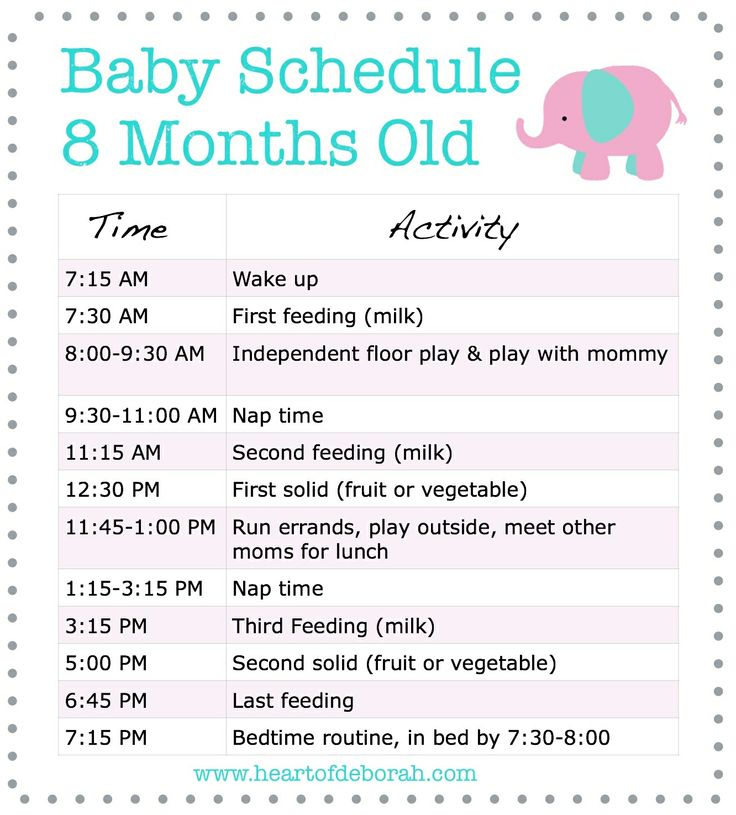2 month old baby feeding and sleep schedule
2 Month Old Baby Schedule | Sample Schedules
2 month old babies need an average of 14-16 hours of sleep a day. Newborns this age generally sleep 9-12 hours at night though not consecutively as they typically need to eat every 2 1/2 to 3 hours, on average. During the day, babies at 2 months old will need to sleep 4-6 hours total. This article outlines the average 2-month-old baby schedule, including milk feedings for breastfeeding and formula-feeding babies, solids, naps, and nighttime sleep. As a sleep consultant for over 10 years, I will also share typical sleep habits and tips to get your baby to sleep through the night. Or, you can simply skip to the schedule if you prefer.
2 Month Old Baby Sleep and Development
At 2 months, your baby is moving past the newborn stage but is still considered a newborn. Your baby is likely extending their wake windows and staying awake longer during the day. They might also be starting to smile more at you and show some personality. It’s such a wonderful time of development!
By 2 months old, your baby’s sleep is likely still a bit erratic as sleep begins to organize. Your baby may sleep in longer stretches at night within the next few weeks, and be awake more during the day. It may take some time to get there, so if your 2-month-old is still very sleepy, that’s normal!
Most 2-month-olds sleep 9-12 hours at night and 4-6 hours during the day broken into several naps. Many 2-month-olds are still eating several times a night or every 3 hours. Bedtimes aren’t always very early at this age given babies aren’t yet sleeping 11-12 hours, yet, as they will at 4 months old. As your baby grows and matures, he or she will consolidate sleep and transition to just 3 naps by 5-6 months old.
You May Also Be Interested In…
- 7 Common Napping Mistakes
- Night Feedings by Age, and When Do You Try Night-Weaning?
- 5 Ways to Help Your Baby Sleep Through the Night
How Many Naps for a 2 Month Old?
Most 2 month old babies take 4 to 5 naps each day that total 4 to 6 hours of sleep.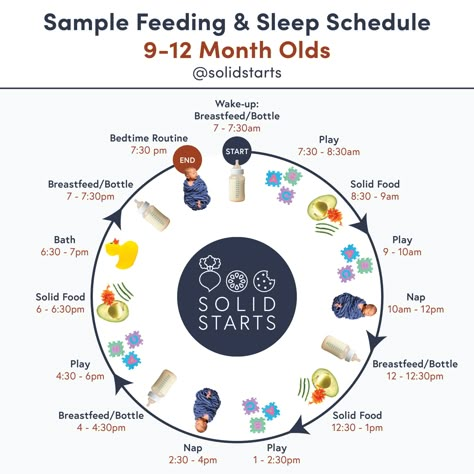 They take so many naps because babies this age stay awake just 1 to 1 1/2 hours at a time. There are a few babies who organize their sleep earlier and will gravitate toward a 4-nap schedule similar to a 4 month old schedule. However, if your baby doesn’t and is taking short naps, this is considered normal. Since they can’t stay awake very long during the day, they often “spread” their total daytime sleep across the day.
They take so many naps because babies this age stay awake just 1 to 1 1/2 hours at a time. There are a few babies who organize their sleep earlier and will gravitate toward a 4-nap schedule similar to a 4 month old schedule. However, if your baby doesn’t and is taking short naps, this is considered normal. Since they can’t stay awake very long during the day, they often “spread” their total daytime sleep across the day.
2 Month Old Baby Feeding
Your baby will likely also start to consolidate feedings beginning around 2 months old, especially if formula-fed. Your baby’s stomach capacity is getting bigger, so your 2-month-old baby will begin to be able to go for longer stretches between night feedings. Do remember, though, that if you are breastfeeding, you’ll want to continue to breastfeed at least every few hours during the day, and your baby will continue to need night feedings at this age, which also maintains your milk supply.
Most babies this age will eat every 3-4 hours during the day.
If your baby is still waking frequently at 2 months old, you may start to wonder about introducing solid food, in order to help your baby sleep. However, keep in mind that starting solids doesn’t usually improve sleep, and 2 months old is still considered too young to begin solid food. It’s best to stick exclusively with breastmilk or formula unless your healthcare provider indicates you should do otherwise.
You May Also Be Interested In…
- 12 Hours By 12 Weeks Old: 10 Important Cautions
- 2-3 Month Old Baby Sleep Guide
- Baby Feeding Chart: How Many Ounces By Age
Sample 2 Month Old Baby Sleep and Feeding Schedules
Putting it all together, all babies are unique, but here are sample schedules you can use to make your own for your unique baby.
Breastfeeding 2 Month Old Baby Schedule (or Babies with small, frequent feedings such as babies with reflux)This first sample schedule is primarily for breastfed babies (or formula-fed babies who have reflux or similar) who eat more frequently during the day.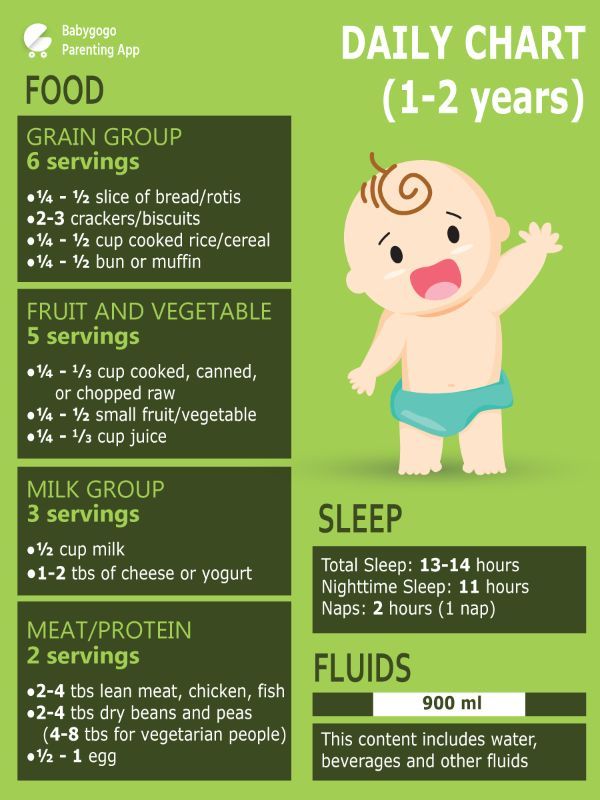 These babies often do better eating before their naps so they will sleep longer at nap time. This is NOT an Eat-Play-Sleep, schedule, though. See below for Eat-Play-Sleep.
These babies often do better eating before their naps so they will sleep longer at nap time. This is NOT an Eat-Play-Sleep, schedule, though. See below for Eat-Play-Sleep.
| 2 Month Old Sleep Schedule With Feedings | |
|---|---|
| Time | Activity |
| 7:00 AM | Wake and Feed (*Fixed Point) |
| 8:30 AM | Morning Nap (*Fixed Point) |
| 9:00 AM | Feed (upon waking; no need to wake baby up!) |
| 11:00 AM | Late Morning Nap |
| 11:30 AM | Feed (upon waking or before the nap if the first nap was longer) |
| 1:30 PM | Feed and Early Afternoon Nap |
| 4:00 PM | Feed and Catnap (30-45 minutes; can be “on the go”) |
| 6:00 PM | Feed and Catnap (30-45 minutes; can be “on the go”) |
| 8:00 PM | Feed and Catnap (30-45 minutes; can be “on the go”) |
| 9:30 PM | Begin your bedtime routine |
| 10:00 PM | Feed and Bedtime (goal to be asleep by this time) |
+ 2-3 night feedings
* We recommend you make these fixed points in your baby’s schedule.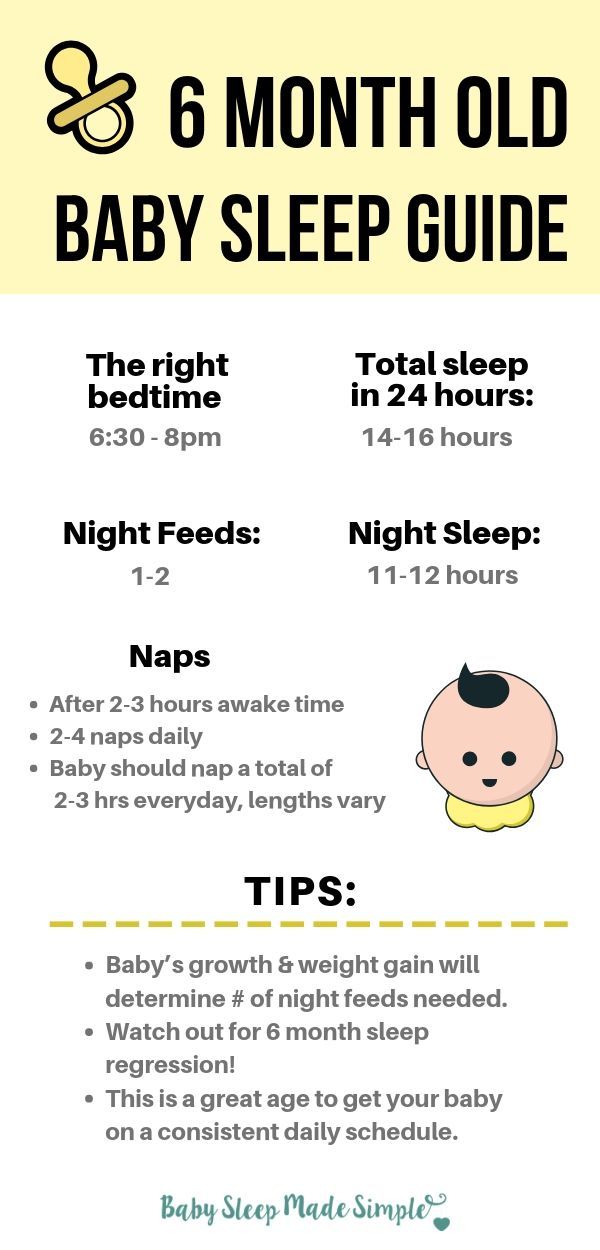 You can read more about this in our article on fixed points in a baby schedule.
You can read more about this in our article on fixed points in a baby schedule.
This second sample schedule is for babies who can go longer between feedings and can follow an Eat-Play-Sleep Scheudle.
| 2 Month Old Sleep Schedule With Feedings | |
|---|---|
| Time | Activity |
| 7:00 AM | Wake and Feed (*Fixed Point) |
| 8:30 AM | Morning Nap (*Fixed Point) |
| 10:00 AM | Feed |
| 11:30 AM | Late Morning Nap |
| 1:00 PM | Feed |
| 2:00 PM | Early Afternoon Nap |
| 4:00 PM | Feed |
| 4:30 PM | Catnap (30-45 minutes; can be “on the go”) |
| 7:00 PM | Feed |
| 8:00 PM | Catnap (30-45 minutes; can be “on the go”) |
| 9:30 PM | Begin your bedtime routine |
| 10:00 PM | Feed and Bedtime (goal to be asleep by this time) |
+ 2-3 night feedings
* We recommend you make these fixed points in your baby’s schedule.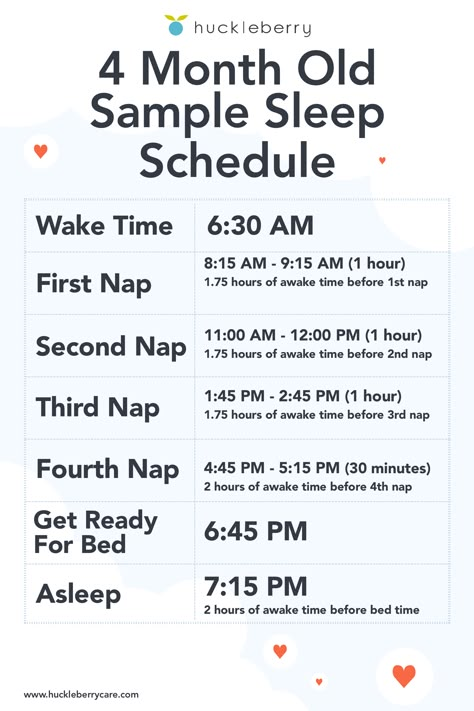 You can read more about this in our article on fixed points in a baby schedule.
You can read more about this in our article on fixed points in a baby schedule.
Note: This schedule follows the eat-play-sleep routine, however, it is sometimes hard to do at this age when the amount of time between naps is not long enough and your baby wakes too early from his nap because of a feeding.
If your baby has already lengthened their nighttime sleep, please consider using one of our 3 month old schedules.
Looking for more sample 2-month sleep schedules?
We have over 40 sample schedules for all ages in our e-Book, Mastering Naps and Schedules. Banish naptime battles and regain control of your day (and your sanity) starting today!
You May Also Be Interested In…
- Custom Schedule Maker (for members only)
- Mastering Naps and Schedules (VIP Members Area digital e-Book)
- Chat Live with a Sleep Consultant (for VIP members only)
- 3 Signs It May Be Time for Night Weaning Your Baby
- Night Weaning Quiz: Is Your Baby Ready To Night Wean?
- How To Put Your Baby On A Schedule (VIP Members Area audio tele-seminar recording with founder)
Want FREE sleep help that you can put to use right away? Download a copy of our free guide, 7 Common Napping Mistakes! The guide is available to download instantly, which means you can start using the techniques in it as early as today.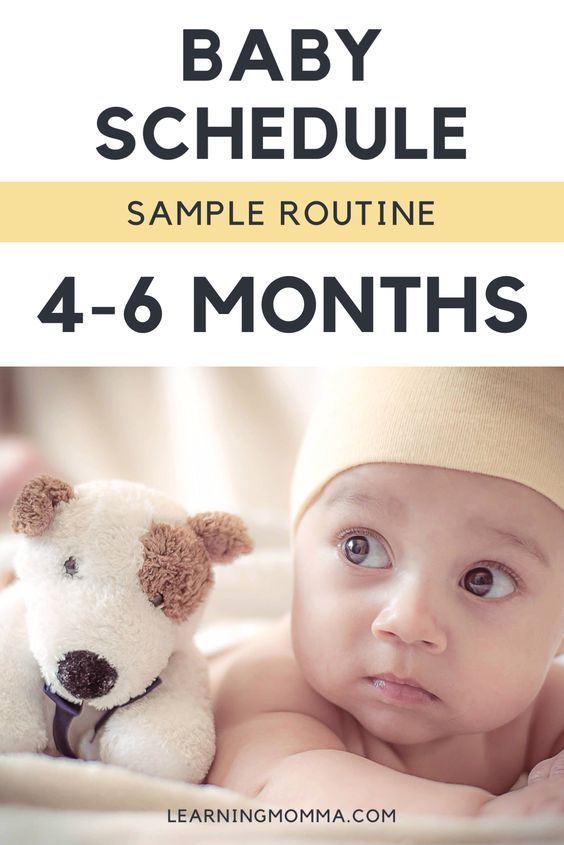 So download now, and learn why your baby is not napping – and what you can do about it.
So download now, and learn why your baby is not napping – and what you can do about it.
Click here to learn more about how to get your free guide.
A better daytime schedule could be just a few clicks away. So don’t wait – download now, and start your journey to better napping today!
The Baby Sleep Site® is a participant in the Amazon Services LLC Associates Program and other product affiliate programs. If you click on a product link and make a purchase, The Baby Sleep Site® may (but not always) receive a small commission from the company selling the product, but will not affect your purchase price. We only recommend products that we believe are quality products and are good for our readers.
Need Baby and Toddler Sleep Help? We Have the Resources You Need!If you are tired of wading through stacks of baby sleep books that just aren't working, if you are beyond exhausted and just can't solve your child's sleep problems on your own.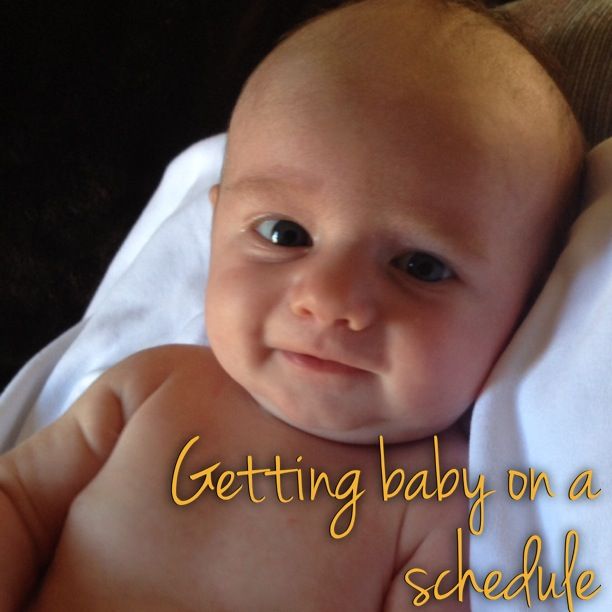 ..then personalized sleep consulting is for you. We have been around since 2008 and invite you to tap into our MANY years of experience. Our team of expert consultants will create a Personalized Sleep Plan® just for your family and then support you through every step of implementing your plan. We encourage you to consider our personalized, one-on-one baby and toddler sleep consultation packages if you want to see real, meaningful results now. Your consultation package also includes ample follow-up help, designed to help you troubleshoot problems and tweak your plan as needed.
..then personalized sleep consulting is for you. We have been around since 2008 and invite you to tap into our MANY years of experience. Our team of expert consultants will create a Personalized Sleep Plan® just for your family and then support you through every step of implementing your plan. We encourage you to consider our personalized, one-on-one baby and toddler sleep consultation packages if you want to see real, meaningful results now. Your consultation package also includes ample follow-up help, designed to help you troubleshoot problems and tweak your plan as needed.
Learn More About Services
For those persistent nighttime struggles, check out The 3 Step System to Help Your Baby Sleep. Using the same unique approach and practical tools for success, this e-book helps you and your baby sleep through the night.
Learn More About The 3-Step System
If you’re looking for ways to get your baby or toddler into a healthy sleeping routine during the day, explore Mastering Naps and Schedules, a comprehensive guide to napping routines, nap transitions, and all the other important “how-tos” of good baby sleep. With over 45 sample sleep schedules and worksheets, Mastering Naps and Schedules is a hands-on tool ideal for any parenting style.
With over 45 sample sleep schedules and worksheets, Mastering Naps and Schedules is a hands-on tool ideal for any parenting style.
Learn More About Mastering Naps
For those persistent toddler sleep struggles, check out The 5 Step System to Help Your Toddler Sleep. Using the same unique approach and practical tools for success, this e-book helps you and your toddler sleep through the night and enjoy a better daytime schedule.
Learn More About The 5-Step System
Join our VIP Members Area packed with exclusive content and resources: e-Books, assessments, detailed case studies, expert advice, and more. As a VIP member, you'll also enjoy a weekly chat with an expert sleep consultant.
Learn More About VIP Membership
Starting a Sleep Schedule for Your 2-Month-Old Baby – Dreamland Baby
Skip to contentNow reading: Starting a Sleep Schedule for Your 2-Month-Old Baby
PrevNextThe first 8 weeks with your baby have likely been a blur.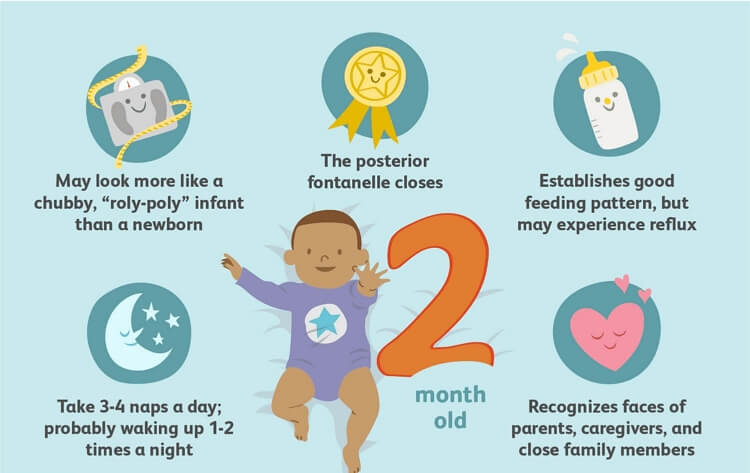 You can chalk it up to overwhelming love for your new little one, sleepless nights, and a range of emotions due to postpartum hormonal changes. As your baby rounds the corner on their 2-month birthday, you're feeling ready to get life on a schedule, and developmentally your baby is ready, too. We know the feeling, which is why we're outlining what you need to know about making a schedule for your 2-month old.
You can chalk it up to overwhelming love for your new little one, sleepless nights, and a range of emotions due to postpartum hormonal changes. As your baby rounds the corner on their 2-month birthday, you're feeling ready to get life on a schedule, and developmentally your baby is ready, too. We know the feeling, which is why we're outlining what you need to know about making a schedule for your 2-month old.
After reading this article you'll have a good idea of what to expect for your 2-month-old in terms of sleep needs, how that fits into a typical 2-month-old schedule, and tips for making it happen.
Wondering if a schedule is right for YOUR two-month-old? Let's start there.
Should you put your 2-month-old on a schedule?
Many parents wonder when it's time to put their baby on a schedule, or if they even should at all.
One of the great things about being a parent is that you get to decide what works best for you and your family.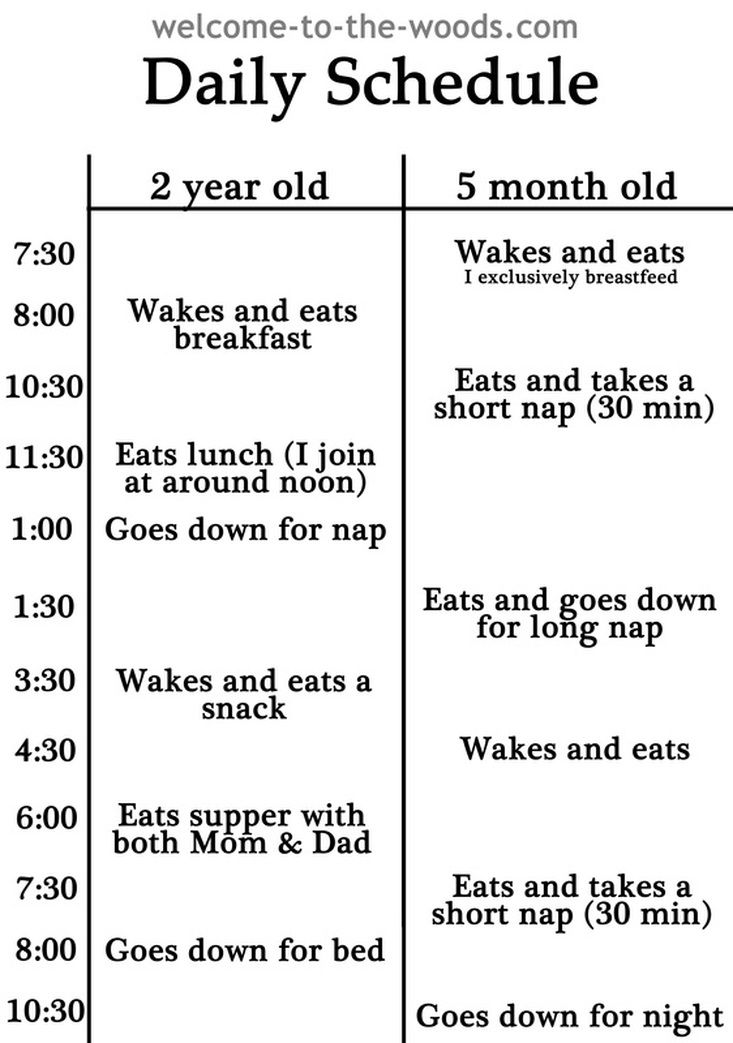 There is definitely no one-size-fits-all approach to parenting. Healthy, thriving and happy children can be raised in lots of different ways.
There is definitely no one-size-fits-all approach to parenting. Healthy, thriving and happy children can be raised in lots of different ways.
To bring you the best advice for helping schedule sleep for your 2-month-old, we’ve consulted with marriage and family therapist Marietta Paxson, from littledreamers.us. She specializes in sleep for babies so we are excited to have her collaboration!
So if you prefer to follow your baby's lead and skip any type of scheduling, that is completely up to you! With that said, creating a schedule for your baby when you think they are ready can allow your family to feel a sense of day-to-day normalcy that helps keep everyone on track.
We don't recommend creating a specific schedule for your newborn baby as we outline in our article "How much does a newborn sleep?", but around 2 months of age (give or take) your baby will be developmentally ready to have more of a routine.
Paxson writes,
“One of the reasons two months is a good age to begin to think about your baby's schedule is because most babies have figured out their days and nights.
”
If at 2 months, you don't feel like you or your baby are quite ready to take on a schedule, then don't push it. Wait a few weeks and then re-assess when they are closer to 3 months old.
Now as we start talking about what a typical schedule could look like for your 2-month-old baby, remember to keep the word "flexible" in mind.
Paxson recommends that you may even want to replace the word “schedule” with routine to keep that flexibility in mind. She writes, “At 2 months of age your baby can get into a great routine that can become fairly predictable.”
Though babies are very capable of getting into the groove of a routine (and usually do quite well on one), they are not robots. They have their own unique personalities and their needs can change quickly as they grow. So, it's important to have a schedule that allows for flexibility. Trying to put your little one on a rigid schedule without any fluidity will only leave you stressed and your baby overwhelmed.
Below we've outlined a possible 2-month schedule. The wake-up time sets the stage for the rest of the schedule, so be prepared to adjust this to when you and your baby typically start your day. And Paxson wants us to remember that the morning wake-up time may change from day-to-day.
A Typical Schedule For a 2-month-old Baby“If your baby is waking in the morning all over the place or your would prefer to start the day at a specific time you can definitely begin waking your baby at a set time every day to help regulate sleep.”
6:30 a.m. - Your baby wakes for the day/First feed
7:30 a.m. - Nap 1 (1.5 - 2 hours)
9:30 a.m. - Feed then play
10:30 a.m. - Nap 2 (1.5 - 2 hours)
12:30 a.m. - Feed then play
1:30 p.m. - Nap 3 (1 - 2 hours)
3:30 p.m. - Feed then play
4:30 p.m. - Catnap (45 minutes - 1 hour)
5:30 p.m. - Feed then play
6:30 p.m. - Bedtime Routine including a Feed
10:00 p.m. - Dream Feed
Trying to get your baby to follow the above "perfect schedule" is not what we're aiming for here.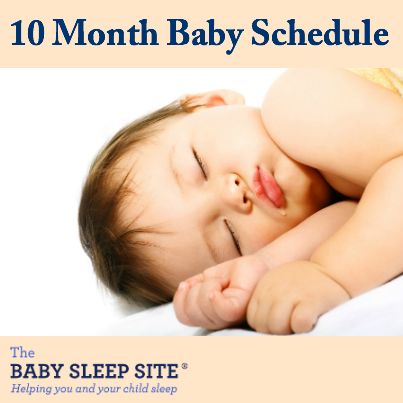 Instead, take into consideration typical needs in terms of a 2-month-old's sleep (outlined below) and then tweak it to what your unique baby needs.
Instead, take into consideration typical needs in terms of a 2-month-old's sleep (outlined below) and then tweak it to what your unique baby needs.
As you begin to create your baby's first "real" schedule, here are some key points to keep in mind in terms of what works best and what a 2-month-old requires.
The sleep-eat-wake pattern is you want to aim for in your baby's day. Let's talk why.
Up until now, your baby's patterns were probably harder to nail down. On top of that, it's natural for newborns to get sleepy very quickly often resulting in a baby who falls right to sleep at the end of a feeding session.
Two months is a great age for your baby to start practicing falling asleep on her own so that you don't always feel like you have to nurse or give her a bottle for sleep to happen.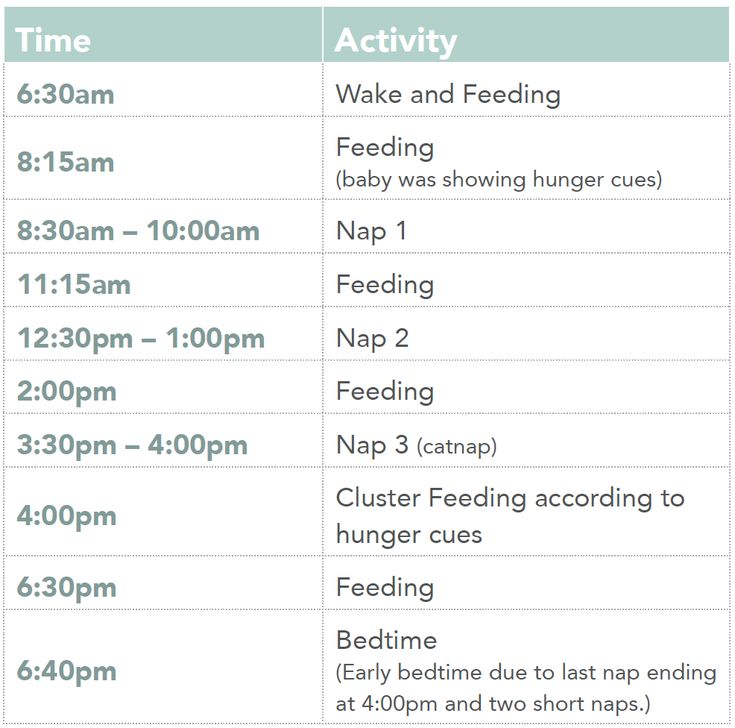
If it doesn't happen right away, don't worry! Just work to keep your baby awake for playtime after a feed. Feeding your baby immediately after they wake will naturally move them into this cycle.
According to Paxson,
About Naps for 2-Month-Olds“The first nap in the morning is usually the easiest nap to get your baby to fall asleep without nursing. This is because the baby is usually the most well-rested in the morning and can gently fall asleep with the least help. It tends to get more difficult as the day goes on. Remember, anytime your baby is able to fall asleep without nursing is a success and it’s okay if it doesn’t happen every time.”
Parents Magazine writes that 6-7 hours of sleep during the day (naps) is ideal at 2 months old. If they're not perfect 1.5-2 hour naps, that's completely ok. Chances are you'll notice a preference from your baby on the time of day they'll take shorter naps and when they'll take the longer ones.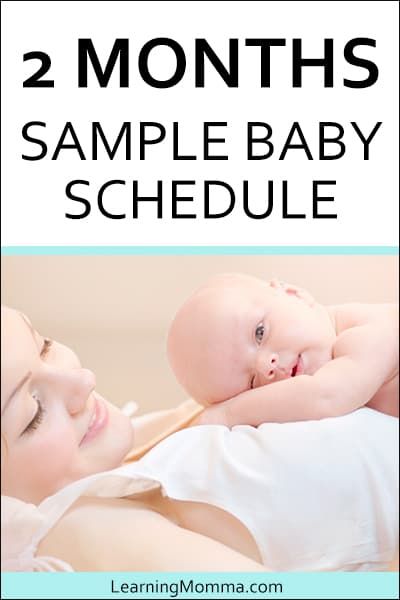 Though 2-hour naps would be lovely, Paxson also wants parents to know that naps ranging from 30-90 minutes are completely normal for infants, too.
Though 2-hour naps would be lovely, Paxson also wants parents to know that naps ranging from 30-90 minutes are completely normal for infants, too.
You’ll start to aim for 3 full naps per day and one shorter catnap in the evening, though a fifth (or even sixth) nap may be necessary if your baby always takes shorter naps.
The CatnapYou'll see that we've included a "catnap." This nap is generally a shorter, yet necessary, part of a 2-month-old's sleep schedule. Though *some* babies may be able to skip this last nap of the day and just go for an earlier bedtime, for others, the time between the last nap of the day and bedtime just gets to be too long.
This overtiredness can be a major culprit in creating a fussy baby in the evening - a time often referred to as the "witching hour."
We recommend including this short 30 minute - 1-hour nap for as long as your baby needs it. will be more developmentally ready to eliminate it. Paxson writes, “As babies get closer to 4 months, naps tend to decrease to 60-90 minutes and sometimes that can mean up to 2 catnaps (naps less than an hour) in order to get to bedtime.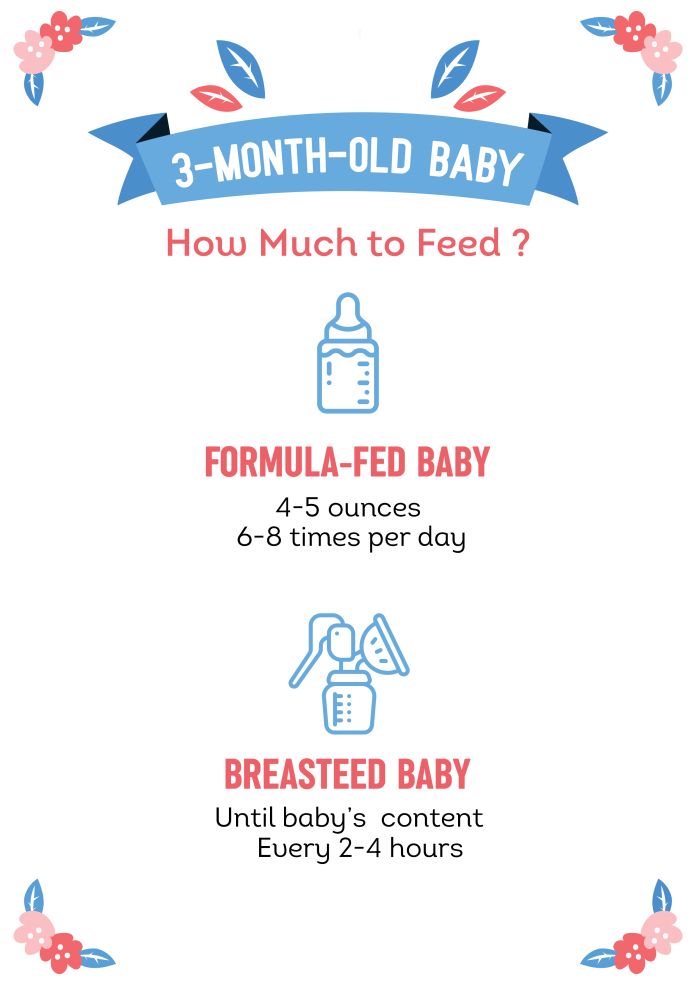 Every newborn is so different!”
Every newborn is so different!”
According to Taking Cara Babies, a baby under 12 weeks of age usually can't stay awake longer than 90 minutes without getting overtired, and you may notice for your baby that it's closer to an hour.
In the schedule above, it aims to have babies awake from 1 hour - 90 minutes.
We recommend keeping a close eye on your little one to watch for his sleepiness cues. You may find that your baby is content for closer to 90 minutes in the morning whereas they may tire more quickly as the day goes on.
Here is Paxson’s suggestion:
The Dream Feed“I recommend wake times at 2 months to land around 60 minutes. Some waketimes may only be 45 minutes and others 75 minutes. Watch for sleepy cues like a glazed expression (or staring into space), red eyes or eyebrows, slower movements or less coos. Your baby may have been awake too long if you start to notice baby getting fussy and acting hungry even though you fed when the baby woke up.
”
The dream feed usually worked wonders with my babies to help them sleep longer stretches at night. We go in-depth about how to structure these late-night feeds in this article, but here's the gist:
The Dream Feed takes place late at night long after your baby has gone to bed, but before you go to sleep for the night. Around 10 o'clock is a great time to do it (that is if you can stay awake that long!) You don't want to fully wake your baby to feed them at this time, but they need to be awake enough to eat. Once you've given them a full feed, you put them right back down to sleep. This tops them off for the night so that you can a really good stretch of sleep before they wake again.
Night Sleep/Feeding NeedsThe above schedule refers to what will take place during the day. This does NOT mean that your baby will sleep through the night. In fact, in our article, "When do babies sleep through the night without feeding?" we reference research that shows that *most* babies won't fully sleep through the night until they are 9 months old and up.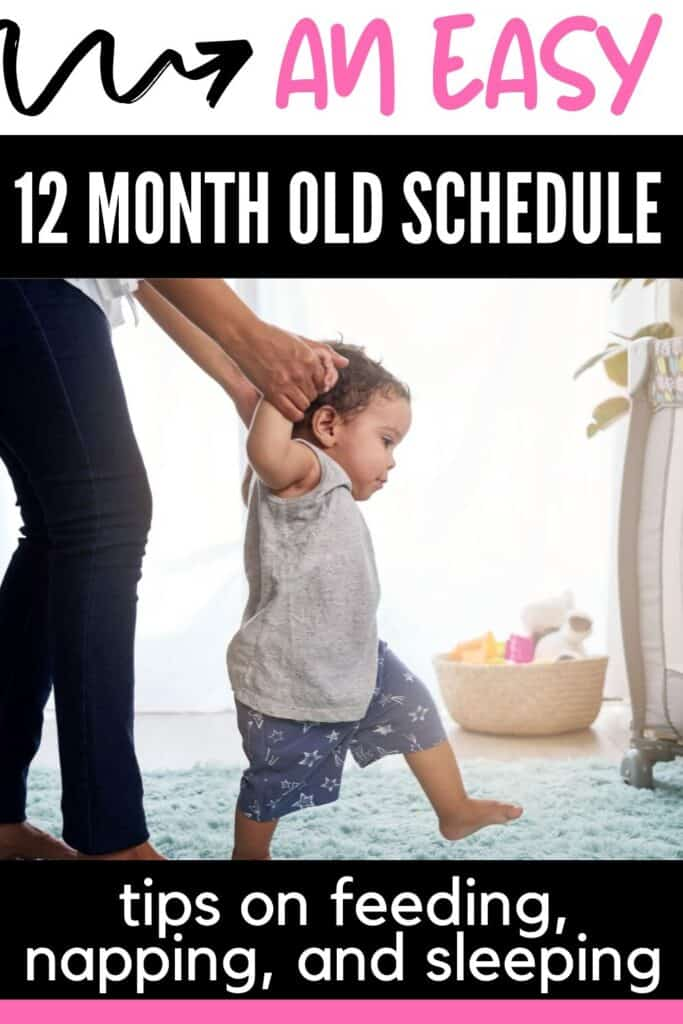
At 2 months old, plan to feed your baby between 6 - 10 times in a 24-hour period. Babies who drink breast milk usually need more feeds per day than babies who are formula-fed.
If your baby is well-rested and getting good feeds during the day you can expect about 2 feeds at night. Your dreamfeed counts as one of those feedings which means you could only need to get up once at night. Remember that because babies are not robots you may see 3 feeds here and there and that is appropriate as well.
Example: Feed at 10 and 2 and baby wakes up at 6am or feed at 11 and 3 and baby wakes at 7 or feed at 12 or 4 and baby wakes at 7.
With each of those considerations in mind, let’s talk about our best tips to start moving your baby into their new routine/schedule.
Tips to Help Your Baby Fall Into a Regular Sleep ScheduleSomething you likely haven't had those first couple of months of your baby's life are longer naps that you can count on. You know...the ones where you can actually get anything done?! Or even take a nap for yourself longer than 2 minutes??
You know...the ones where you can actually get anything done?! Or even take a nap for yourself longer than 2 minutes??
With your baby's sleep schedule, you're trying to help them learn to take longer naps which will in turn help stretch their period of sleep at night, too. (Though you don't want your baby to sleep longer than 2 hours at a time during the day or that could cause them to party all night.)
Here are some tips to help your baby stretch those naps and fall into more of a schedule:
- Get your baby up about the same time each morning. This will help regulate your baby's brain and body to begin to get on a schedule. Don't expect perfection early on and be flexible in adjusting your baby's day as needed. But this is the goal you're working towards. A baby on a good morning wake up routine will wake within about a 30-minute window each day
- Aim for full feeds: Feeding is a big part of your 2-month-old's schedule in order to get them to fall into more visible sleep patterns.
 This is because in order to get longer naps and good stretches of sleep at night, you need to be focusing on getting your baby's tummy nice and full at each feeding. This means spacing feeds out to about every 2-3 hours if breastfeeding and 3 hours if bottle feeding. And remember cluster feeding in the evening is normal!
This is because in order to get longer naps and good stretches of sleep at night, you need to be focusing on getting your baby's tummy nice and full at each feeding. This means spacing feeds out to about every 2-3 hours if breastfeeding and 3 hours if bottle feeding. And remember cluster feeding in the evening is normal! - Be mindful of sleepiness cues:Once your baby shows signs of being tired you want to start getting them ready to take their nap. Overtired babies have a hard time falling asleep and staying asleep.
- Lay your baby down drowsy, but awake:This is the best way to teach your baby to become an independent sleeper. You can see our gentle methods that we recommend in our article, “A Helpful Guide for Sleep Training Your Baby,” and Marietta Paxson offers a video course that highlights how to help babies fall asleep in their cribs for newborns (find at littledreamers.us).
- Follow the same routine every time you lay your baby down for a nap: Things like swaddling your baby in a Dreamland Baby Weighted Swaddle, using white noise, and laying them down in a dark and quiet room signal to your baby that it's time to sleep.

- Use our suggested nightly crib routine: Read our article, "How to Get Your Baby to Sleep in a Crib," to find out how you can start getting your little one transitioned to their own room for nighttime sleep if you haven't already. If you feel like it's too early, you can still use our suggestions to prepare your little one for nighttime sleep.
- Put your baby to bed about the same time each night. Unlike you, your baby's circadian rhythms aren't yet established. Sticking to regular bedtimes will help them to learn that nighttime is meant for sleeping (even though they'd much prefer to snuggle with you.) It’s important to note that there really isn’t an “ideal” bedtime for a newborn, so Paxson reminds you to watch your baby and trust your instinct.
The weeks fly by and soon your baby will be 3 months old! It's amazing how much your baby's needs can change from month-to-month at this age, so be sure to check out our article “Sleep Schedule and Routine for Your 3-Month-Old” to see what's coming up next.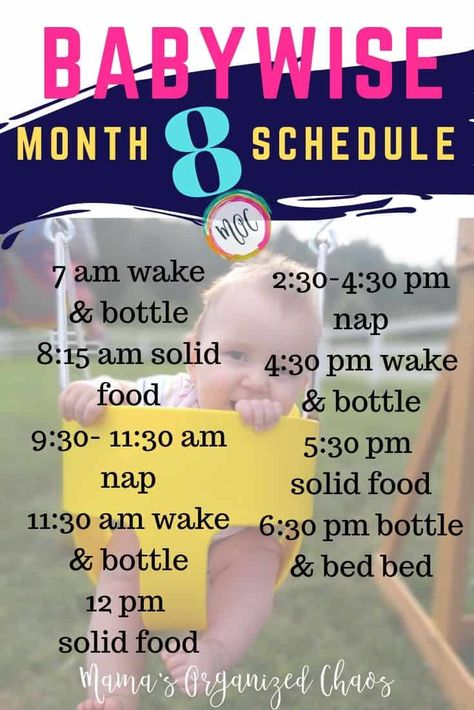
Marietta Paxson is a marriage and family therapist who specializes in sleep from 0-4 years. She is a mom of four, including twins, who have experienced almost every possible sleep concern or regression out there. She knows what it's like to not be sleeping and she also knows how good it feels to start sleeping better. She is committed to helping parents navigate sleep so that the whole family can enjoy their time together more.
Marietta M. Paxson, M.S., LMFT
Little Dreamers
(435) 770-8312
[email protected]
www.littledreamers.us
www.facebook.com/littledreamers.us
@littledreamers.us
A Sleep Schedule for Your 6-9-Month-Old and What to Expect
Establishing a Sleep Schedule for Your 4 – 6 Month-Old Baby
The daily routine of a child at 2 months: development, sleep, feeding
03/21/2019
90
At 2 months, your baby is no longer the same as it was only 4 weeks ago.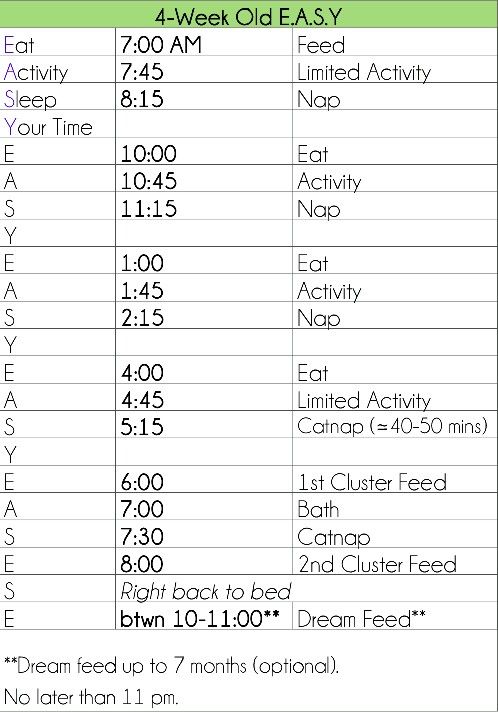 The baby becomes more active, his sense organs develop, his sleep and wakefulness change. We tell you what you need to consider when shaping the daily regimen of two-month-old children on breastfeeding and artificial feeding.
The baby becomes more active, his sense organs develop, his sleep and wakefulness change. We tell you what you need to consider when shaping the daily regimen of two-month-old children on breastfeeding and artificial feeding.
Sleep at night
By 2 months you will notice that your baby's sleep patterns are changing. The biological rhythms of the baby continue to form, and the duration of night sleep gradually increases. The child will begin to go into the night earlier - at 22.00-23.00 hours. But for the time being, bedtime is not as important as whether the baby gets enough sleep. Many children sleep around 9-10 hours at night with awakenings for feeding. How long you should be between night feeds is best discussed with your pediatrician. The time of the morning rise is also not yet constant and not always at 7 in the morning.
Daytime sleep
The duration and time of daytime naps are still different, as well as the time of wakefulness between them. In general, a two-month-old baby sleeps approximately 4-5 hours during the day. And sleep segments are now usually from 30-40 minutes to an hour. During the day, the child sleeps from 4 to 6 times - depending on the time of getting up and leaving at night.
In general, a two-month-old baby sleeps approximately 4-5 hours during the day. And sleep segments are now usually from 30-40 minutes to an hour. During the day, the child sleeps from 4 to 6 times - depending on the time of getting up and leaving at night.
Baby can be active for up to 1 hour or 1 hour and 15 minutes. But you should not allow overwork and focus also on the signs of fatigue and the duration of the previous sleep.
If a two-month-old baby calms down, loses interest in surrounding objects, starts rubbing his eyes, directs his eyes to one point, for no reason starts to get nervous and asks for food, then he wants to sleep and it's time to go to bed.
How many hours of sleep is needed in general? A newborn needs 14-16 hours of sleep a day.
By this age, you already understand your baby better, and it will be easier to follow a more or less understandable schedule. Although the exact daily routine has not yet been organized.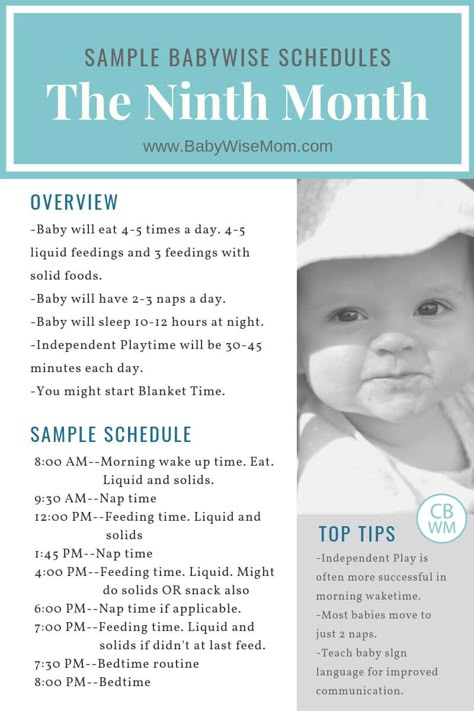
Why can a two-month-old baby not sleep?
If bedtimes are long and it is difficult for the child to fall asleep during the day, the causes of sleep disturbances should be found out and, if possible, eliminated:
-
At this age, the baby begins to be distracted by the surrounding objects, so be sure to darken the room. Darkness will help calm the baby and set him to sleep. This is especially important if you have trouble falling asleep in the evening. From 2.5 months, the sleep hormone melatonin begins to be produced. Therefore, remember that bright light destroys it, and darkness, on the contrary, contributes to the formation of melatonin in the child's body.
-
At 2 months, the sense organs are actively developing in babies. Now the child reacts to any rustle. And those sounds that he did not notice before can now wake him up during sleep. The use of a white noise generator will help here to protect the baby from extraneous noise.
 It is not recommended to buy special toys with white noise that are placed in the crib, as this is not safe.
It is not recommended to buy special toys with white noise that are placed in the crib, as this is not safe. -
Even an extra 5-10 minutes can affect the child's well-being this month and lead to more overwork. If this happens, use different ways to calm the baby and put him to bed.
Now is the time to introduce a ritual that will help set the baby to sleep. Daily repetition of activities facilitates the process of falling asleep and improves night sleep. Start by bathing, lightly massage your baby, swaddle, feed in dim light, walk with your baby upright to ease spitting up.
At the end, read a story or sing a lullaby. Separating feeding and falling asleep will help your baby learn to fall asleep on his own in the future, not relying only on the breast. Gradually, food will become part of the ritual, and not the only way for the child to fall asleep.
Lay the baby sleepy, but awake, in the crib, stroking the head and tummy if necessary.
If it’s hard to adjust the baby’s sleep and routine on your own, come to the Club REGIME FROM A TO Z.
How to avoid confusion between day and night
.
When you are awake, take your baby outside, turn on the lights and open the curtains. Let the child be surrounded by familiar everyday sounds while playing.
Avoid bright lights at night, feed and change diapers with minimal light if possible. If the baby wakes up at night, be quiet and do not play with him.
In the table you will find the norms of sleep and wakefulness of a child at 2 months
Feeding and daily routine of a child of 2 months
The daily routine of a 2-month-old baby on breastfeeding and on artificial feeding is almost the same. The only difference is the feeding schedule. Since the mixture is digested more slowly, meals will be less frequent. The feeding regimen should be discussed with the doctor observing the child.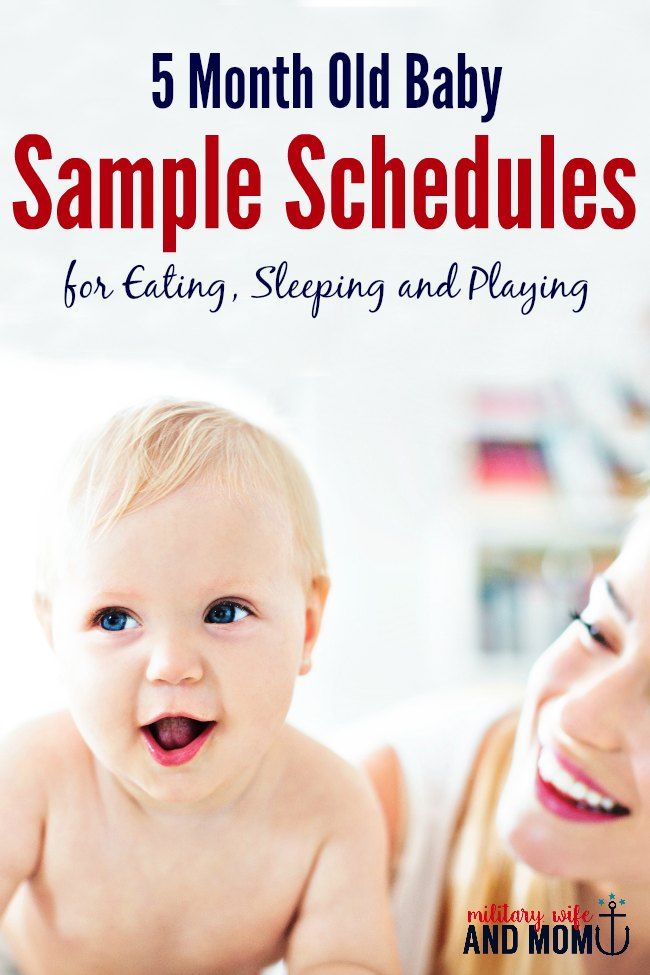 As in the case if the baby was born prematurely or does not gain weight.
As in the case if the baby was born prematurely or does not gain weight.
At two months, the number of attachments with natural feeding during the day is about 6-9, at night - from 2 to 4 times. For a two-month-old baby, about 800-900 ml is enough. milk or 700-750 ml. mixture per day. The menu should not include other fluids while breastfeeding. Feeding on demand usually occurs at 2 months for 15-20 minutes.
A baby of the second month of life has a need for contact with the outside world. He begins to be distracted by environmental stimuli during breastfeeding and eats less milk or formula during the day than he needs. Have you noticed this with your child?
Therefore, offer breasts during sleep and after waking up. And during feeding, retire with the baby in a quiet place, darken the room so that nothing distracts the baby, and offer him the breast in a calm environment.
Baby development at 2 months
At this age, babies develop a reflex that makes them look at their outstretched arms when they wave them.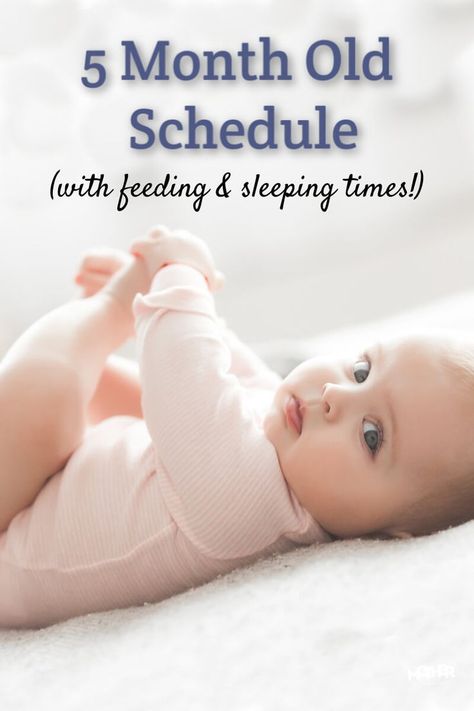 The child gets used to his body and learns it. Surely, your baby loves to take his fingers in his mouth and touch his legs with his hands! And now you will notice the first smile - smile and you will respond in order to establish contact with the child.
The child gets used to his body and learns it. Surely, your baby loves to take his fingers in his mouth and touch his legs with his hands! And now you will notice the first smile - smile and you will respond in order to establish contact with the child.
A 2-month-old baby turns its head towards sounds, follows objects with its eyes, holds its head and starts pushing with its arms while on its stomach.
2 months - a period of active development of strength, balance and coordination of the child, which is important for the formation of motor skills of the baby.
During waking hours it is useful to walk in the fresh air with the baby, communicate and play with the child.⠀
Continue to use the developmental mat, on which toys can already be hung, Place them on the sides so that the baby turns his head, follows them and reaches for them. Or read picture books so that the baby also actively follows the story with his eyes.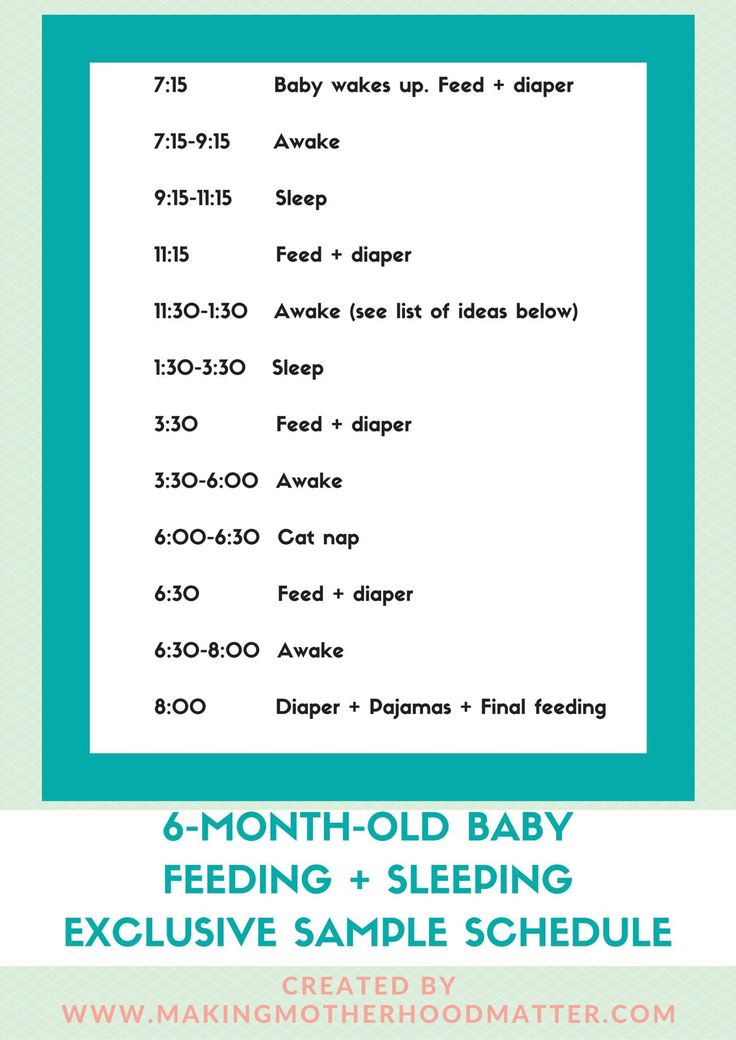 Lay the baby on your stomach. Offer rattles to your child while walking.
Lay the baby on your stomach. Offer rattles to your child while walking.
Share in the comments what daily routine did you have in 2 months? Did you have any difficulties?
Like this article? Rate:
Votes: 360
Daily routine for a child under 1 year old
Daily routine is a system for distributing periods of sleep and wakefulness, meals, hygiene and health procedures, activities and independent human activities throughout the day.
Compliance with a rational day regimen corresponding to the age characteristics of the child contributes to his healthy growth and development. Getting used to performing various types of activities at the same time, the child is prepared for the upcoming type of activity at every moment of time, which ensures their easier and faster implementation. Compliance with the correct daily routine provides a good mood for the child and maintains a keen interest in the study of the world around him, contributing to his normal motor and psychoverbal development.
Compliance with the correct daily routine provides a good mood for the child and maintains a keen interest in the study of the world around him, contributing to his normal motor and psychoverbal development.
The child's daily routine includes the following obligatory elements: diet, time spent outdoors during the day, frequency and duration of sleep, mandatory classes to develop skills in accordance with age, free time.
In the first months after birth, a healthy newborn baby sleeps for most of the day, since all external stimuli are very strong for the nervous system of a child, accustomed to a cozy intrauterine environment, and cause its rapid exhaustion. As the child grows older, the duration of sleep gradually decreases and the time of wakefulness increases.
| Age | Daytime sleep mode | Night sleep | Wake mode |
| Birth to 2 months | 6 x 2. 5 hours 5 hours | 6 hours | During feeding |
| 2-4 months | 5 times 2-2.5 hours | 6.5 hours | 4 x 1.5 hours |
| 4-6 months | 4-5 times for 2 hours | 7 hours | 4 times 2 hours |
| 6-9 months | 3-4 times for 1.5-2 hours | 8 hours | 4 x 2.5 hours |
| 9-12 months | 2 x 1.5-2 hours | 9-10 hours | 4 times 3-4 hours |
Closely related to the sleep-wake mode is the feeding mode of the baby. The sleep of a child in the first months of life is very sensitive and is easily disturbed under the influence of various extraneous stimuli, including hunger.
| Age | Mode | Example |
| Birth to 2 months | 7-8 times, every 3 hours | 6,9,12,15,18,21,24 (no night feeding) |
| 2 to 6 months | 6-7 times, every 3.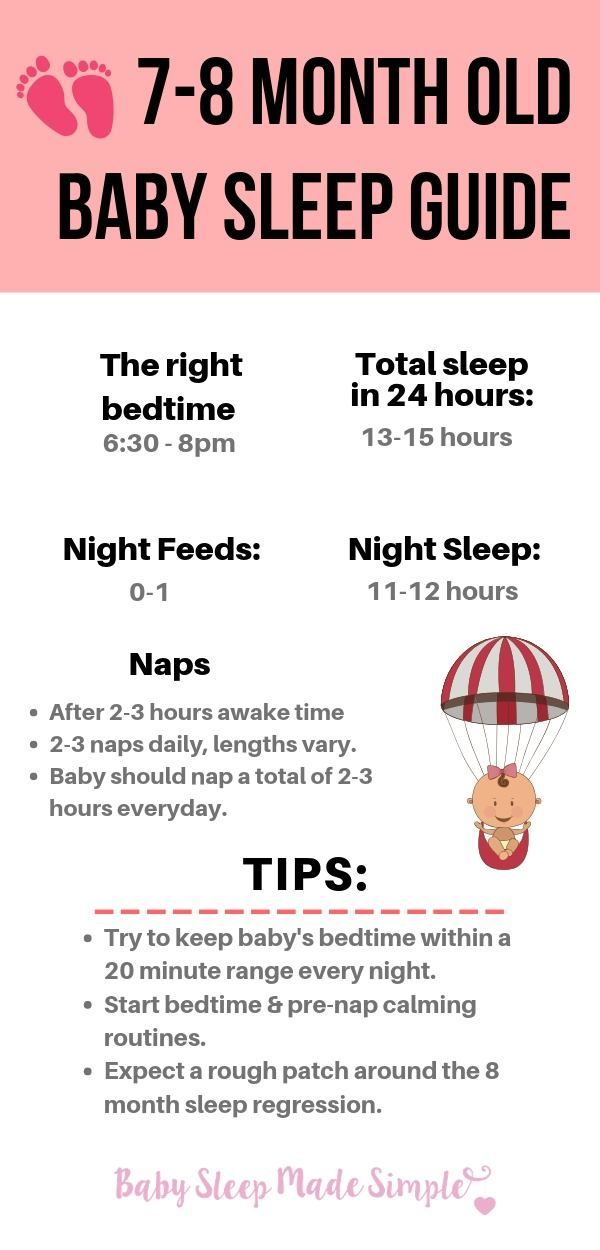 5 hours 5 hours | 6, 9.30, 13, 16.30, 20, 23.30 (without night feeding) 6, 9.30, 13, 16.30, 20, 23.30, 03 (with night feeding) |
| From 7-12 months | 5 times, every 4 hours | 6,10,14,18,22 |
The child's stay in the fresh air is essential in the daily routine. The total duration of stay in the open air for children under 1 year of age should be at least 5-6 hours a day. Fresh air has a calming effect on the baby, improves metabolic processes, and increases the body's defenses. In the summer, all games and activities should be held outdoors; in the cold and transitional seasons, two one-time walks of 1.5-2 hours are provided.
Fresh air also has a beneficial effect on sleep. By acting on the skin and mucous membranes of the nose and upper respiratory tract, it provides a faster fall asleep of the child and a higher quality of sleep. Sleeping outside can replace a walk, especially during the cold season.